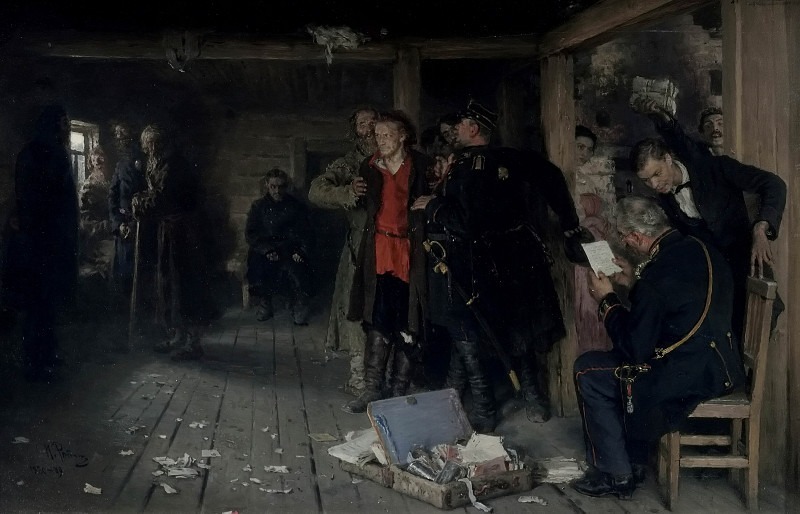The arrest of the propagandist Ilya Repin (1844-1930)
Ilya Repin – The arrest of the propagandist
Edit attribution
Download full size: 4200×2695 px (0,8 Mb)
Painter: Ilya Repin
Location: The State Tretyakov Gallery, Moscow (Государственная Третьяковская галерея).
The artist first conceived of painting this painting after he had to witness the massacre of the "people’s criminals." As you know, these people were not criminals at all, they just did not want to obey the authorities. This trial was later called "The Process of 193". These events took place in St. Petersburg in 1878. The final version of the picture "the arrest of a propagandist," which Repin began to write back in 1880, appeared only a few years later.
Description of Ilya Repin’s painting Arrest of a Propagandist
The artist first conceived of painting this painting after he had to witness the massacre of the "people’s criminals." As you know, these people were not criminals at all, they just did not want to obey the authorities. This trial was later called "The Process of 193". These events took place in St. Petersburg in 1878.
The final version of the picture "the arrest of a propagandist," which Repin began to write back in 1880, appeared only a few years later. The artist was constantly refining it, believing that it lacked something. All the changes he made because he wanted to maximize the honesty and truthfulness of the picture.
In fact, it turned out it was very real. Repin highlighted the main character through the use of various artistic means. His bright red shirt contrasts with the surrounding background. Similarly, his thoughts, views, and understanding of life are also different. He sees the reality around him differently than all those who arrest him. He is a true revolutionary with progressive views and ideas. The propagandist is located in the very center. Because of this, the artist has skillfully captured his gaze. The revolutionary looks very harshly at the man located at the very wall. In his eyes there is hatred towards him, but he is not afraid. He is very calm. It is this calmness that emphasizes the fact that the prisoner has an indomitable will and strength of spirit.
Everyone else is completely unconcerned about how the hero’s future fate will unfold. The crowd is simply curious to see how events unfold.
"The Arrest of a Propagandist" belongs to the "Narodnaya Volya" series of works by the artist.
Кому понравилось
Пожалуйста, подождите
На эту операцию может потребоваться несколько секунд.
Информация появится в новом окне,
если открытие новых окон не запрещено в настройках вашего браузера.
You need to login
Для работы с коллекциями – пожалуйста, войдите в аккаунт (open in new window).




















COMMENTS: 1 Ответы
Какие огненные уши у полицейских! Стыдно перед потомками!
You cannot comment Why?
Surrounding this central action are other individuals whose reactions and roles are implied by their placement and attire. To the left, shadowy figures seem to be observing from a distance, some with concerned or somber expressions. To the right, a man in formal attire holds up a stack of papers, possibly evidence or documents, while another figure leans in, seemingly examining them.
A key element is a seated figure in uniform in the foreground, engrossed in reading a document. This character appears to be in a position of authority, perhaps an investigator or a higher-ranking officer, presiding over the proceedings. Scattered papers and an open, disheveled briefcase on the wooden floor suggest that a search has occurred and incriminating materials have been found.
The overall atmosphere is one of tension and suppression. The dark color palette, the stark lighting that highlights key figures while obscuring others, and the depiction of surveillance and apprehension all contribute to a narrative of political intrigue and the silencing of dissent. The title, The Arrest of the Propagandist, directly points to the subtext: the persecution of individuals spreading ideas deemed subversive or dangerous by the authorities. The scene likely represents a moment of confrontation between a revolutionary or an activist and the established power structure of the time.